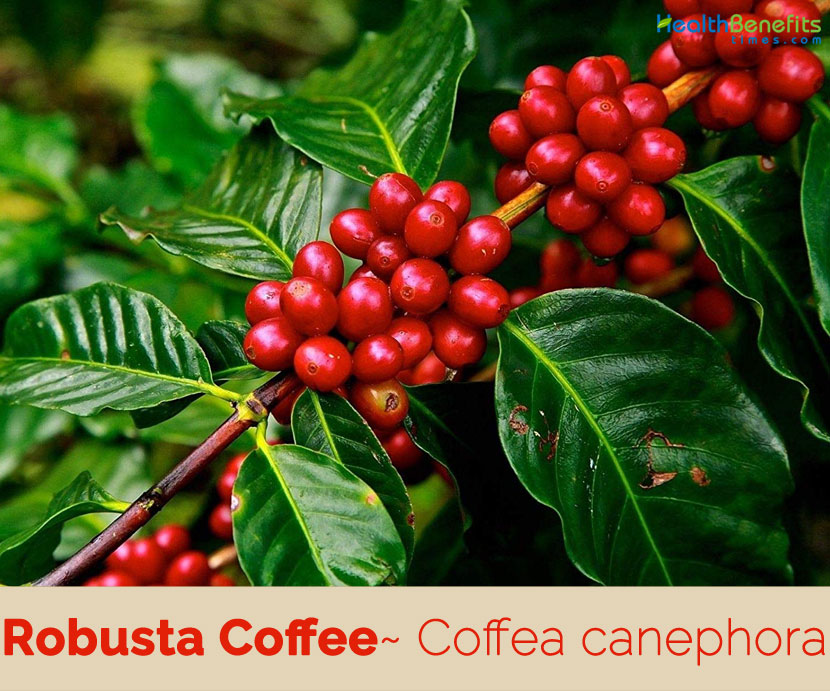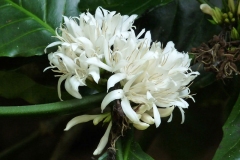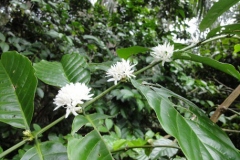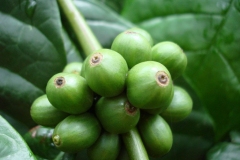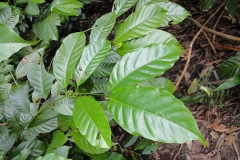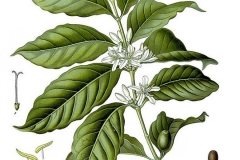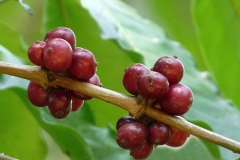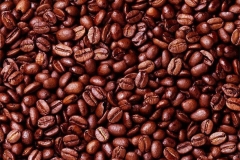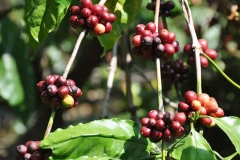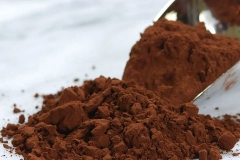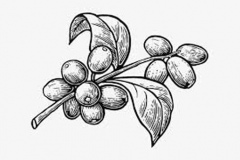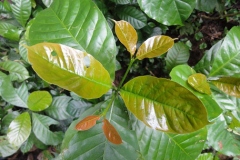| Robusta Coffee Quick Facts | |
|---|---|
| Name: | Robusta Coffee |
| Scientific Name: | Coffea canephora |
| Origin | Central and western sub-Saharan Africa |
| Colors | Green when young turning to Red as they mature |
| Shapes | Round, 1.0-1.2 cm across, smooth when dry |
| Taste | Bitter, rubbery/grain-like flavor |
| Health benefits | Beneficial for asthma, atropine poisoning, fever, flu, headache, jaundice, malaria, migraine, narcosis, nephrosis, opium poisoning, sores and vertigo |
| Name | Robusta Coffee |
|---|---|
| Scientific Name | Coffea canephora |
| Native | Central and western sub-Saharan Africa |
| Common Names | Congo coffee, Congo coffeetree, Robusta coffee, robusta coffee tree |
| Name in Other Languages | Arabic: Bin qasbi (بن قصبي) Assamese: Kaphi (কফি) Bengali: Kaphi(কফি) Bulgarian: Kafe robusta (кафе робуста) Catalan: Cafè robust Chinese: Zhong guo ka fei Czech: Kávovník statný Dutch: Robusta koffie English: Congo coffee, Congo coffeetree, Robusta coffee, robusta coffee tree Esperanto: Fortika kofeo Estonian: Kongo kohvipuu Finnish: Kongonkahvi French: Café robusta, Caféier robuste, Caféier canéphore German: Robustakaffee, Robustakaffeebaum, Robustakaffeestrauch, Kongo-Kaffeestrauch Gujarati: Kophi (કૉફી) Hebrew: קפה רובוסטה Hindi: Kafi (काफ़ी), kophi (कॉफी) Hungarian: Robuszta kávé Indonesian: Robusta Italian: Caffe di Congo, caffè robusta Japanese: Robusuta koohiii (ロブスタコーヒーノキ) Kannada: Kaaphi (ಕಾಫಿ) Konkani: Kawphi (कॉफि) Malayalam: ṟēābasṟṟa kāppi (റോബസ്റ്റ കാപ്പി), kaappicceti (കാപ്പിച്ചെടി) Manipuri: Kophi Marathi: Kava (कवा), kophi (कॉफि) Mizo: Kaw-fi Nepali: Kahuwa (कहुवा), kaphi (काफि) Persian: قهوه کانفورا Polish: Kawa kongijska Portuguese: Café-robusta, cafeiro, café Russian: Kofe robusta (Кофе робуста), Kofe kongolezskiy (Кофе конголезский) Slovak: Kávovník robusta Spanish: Cafeto robusto, café robusta Swedish: Robustakaffe Tamil: Kapi (காபி) Telugu: Kaaphii (కాఫీ) Thai: Kafae Ukrainian: Robusta (Робуста) Vietnamese: Càphê robusta, Cà phê vối |
| Plant Growth Habit | Robust tree or shrub |
| Growing Climates | Open or dense rain-forest, forest margins and to desert areas |
| Soil | Prefers a well-drained fertile, neutral to slightly acid soil. Succeeds in shallow soils in areas of high rainfall, and will stand temporary water logging |
| Plant Size | About 12 m tall |
| Root | Shallow root system |
| Leaf | Leaves are drying thickly papery, elliptic, elliptic-oblong, or occasionally ovate-oblong, 15-30 cm long 6-12 cm wide, hairless on both surfaces, base wedge-shaped to broad |
| Inflorescence | Inflorescences with cymes 1-3 in each leaf axil, each cyme 3-6-flowered, stalk less to stalked with stalks up to 7 mm. Flower-stalks are up to 2 mm |
| Flower | White to pink, funnel-shaped. Flower tube is 5-16 mm; petals 5-7, spatula-shaped to narrowly elliptic, 8-19 mm, obtuse to rounded |
| Fruit Shape & Size | Round, 1.0-1.2 cm across, smooth when dry, hairless |
| Fruit Color | Green when young turning to Red as they mature |
| Varieties |
|
| Propagation | By seed |
| Taste | Bitter, rubbery/grain-like flavor, with a pea nutty aftertaste. |
| Plant Parts Used | Seeds |
| Precautions |
|
Plant Description
Robusta coffee is a very variable evergreen shrub or small robust tree growing up to 12 meters tall, though usually smaller. It often has a large, umbrella shaped growth habit. The plant is often found growing in open or dense rain-forest, forest margins and to desert areas. The plant prefers a well-drained fertile, neutral to slightly acid soil. It can also succeed in shallow soils in areas of high rainfall, and will stand temporary waterlogging. The plant has a shallow root system and grows as a robust tree.
It can grow in low altitudes, as well as diverse climatic conditions. Farmers love to grow it because grows faster, and is more disease and pest-resistant than Arabica coffee. Canephora beans are associated with producing coffee beans that are very bitter and have a low acidic rate. As a result of their high bitterness level the coffee beans cannot be used in every brew. The canephora beans are primarily used for espresso, traditional instant coffee (Waka uses only 100% Arabica beans), or as a filler for lower-grade ground coffee blends as they produce a strong flavor of coffee.
Leaves
Leaf-stalk is 1-2 cm long and hairless. Leaves are drying thickly papery, elliptic, elliptic-oblong, or occasionally ovate-oblong, 15-30 cm long and 6-12 cm wide, hairless on both surfaces, base wedge-shaped to broad, margins flat or occasionally crisped-wavy, tip long-pointed with tip 1-1.8 cm. Secondary nerves are 10-12 pairs.
Flowers
Inflorescences with cymes 1-3 in each leaf axil, each cyme 3-6-flowered, stalk less to stalked with stalks up to 7 mm. Flower-stalks are up to 2 mm. Sepal cup is hairless. Flowers are white to pink, funnel-shaped. Flower tube is 5-16 mm. Petals is 5-7, spatula-shaped to narrowly elliptic, 8-19 mm, obtuse to round.
Fruits
The plant flowers irregularly, taking about 10-11 months for cherries to ripen, producing oval shaped beans. Fertile flowers are followed by round berries 1.0-1.2 cm across, smooth when dry and are hairless. Fruits are initially green turning to bright red as they mature. Robusta plant has a greater crop yield than that of Coffea arabica. As it is less susceptible to pests and disease, Robusta needs much less herbicide and pesticide than Arabica.
History
The Coffea Canephora originated in the northern forests of Ethiopia and now grows indigenously throughout western and central sub-Saharan Africa (Liberia – Tanzania – Angola). Since the original discovery of the Coffea plant, it has naturalized and made its way to other hot places around the world, like Vietnam, Nicaragua, Costa Rica, and the Lesser Antilles.
Important Varieties of Robusta Coffee in India
The two major varieties of Robusta Coffee in India are:
S.274 Coffee
This variety of Robusta coffee is a selection made from the high yielding old Robusta coffee collection that was brought to India from Sri Lanka. It’s the most commonly grown variety among India’s major Robusta coffee growing regions. The sturdy bushes of the S. 274 coffee plant are strong, and can adapt across distinct regions. Its seeds (or beans) are bold, round and greyish colored (after wet processing).
CxR Coffee
This variety of Robusta coffee is a hybrid of Robusta coffee and Coffea congenisis. The bushes of this plant variety are more compact, with smaller and narrower leaves compared to conventional Robusta plants. Its seeds (or beans) are bold, with soft and neutral features in the cup compared to conventional Robusta coffee.
Traditional uses and benefits of Robusta Coffee
- Seed consist of caffeine, a widely used stimulant that is also used in proprietary painkillers to potentiate the effect of aspirin and Paracetamol.
- It also consists of the stimulants theobromine and theophylline, as well as chlorogenic acid, which are stimulant and diuretic as well as a known allergen.
- Seed is a bitter, aromatic, stimulant herb that has diuretic effects and controls vomiting.
- It is reported to be analgesic, an aphrodisiac, anorexic, antidotal, cardio tonic, CNS-stimulant, counter-irritant, diuretic, hypnotic, galactagogue and nervine.
- Whilst not usually recognized as a medical herb, coffee is a highly effective general stimulant, having a particular effect upon the central nervous system, improving perception and physical performance.
- It has been found of help in some cases of headache or migraine.
- An enema made using coffee beans is an effective cleanser for the large bowel.
- Coffee is a folk remedy for asthma, atropine poisoning, fever, flu, headache, jaundice, malaria, migraine, narcosis, nephrosis, opium poisoning, sores and vertigo.
- The bean is also popularly used in skin care therapy.
- The Robusta bean is rich in antioxidants, which are popular elements of cellular rejuvenation.
- Cup of coffee in the morning does not only wake you up, but also encourage your cells to heal.
- Due to its acidic content, Robusta beans are more coveted ingredients in facial or body masks to remove excess oil and dead cells.
Other Facts
- In recent years, Vietnam, which produces mostly Robusta, has become the world’s largest exporter of Robusta coffee, accounting for over 40% of the total production.
- Brazil is still the biggest coffee producer in the world, producing one-third of the world’s coffee, though 70% of that is C. arabica.
- Coffelite, a type of plastic, is made from coffee beans.
- Coffee, with iodine, is used as a deodorant.
- Seeds consist of caffeine, which has been described as a natural herbicide, selectively inhibiting germination of seeds of Amaranthus spinosus.
- Pulp and parchment are used as manure and mulches.
- Indonesia is one of the highest Robusta producers.
- Robusta is the hardier, resilient plant that doesn’t need much special treatment.
References:
https://www.itis.gov/servlet/SingleRpt/SingleRpt?search_topic=TSN&search_value=506060#null
https://plants.usda.gov/core/profile?symbol=COCA39
https://en.wikipedia.org/wiki/Coffea_canephora
https://npgsweb.ars-grin.gov/gringlobal/taxonomydetail.aspx?id=11092
https://www.cabi.org/isc/datasheet/14793
http://www.theplantlist.org/tpl1.1/record/kew-45464
https://indiabiodiversity.org/species/show/265166
https://www.flowersofindia.net/catalog/slides/Robusta%20Coffee.html
https://gd.eppo.int/taxon/COFCA
http://tropical.theferns.info/viewtropical.php?id=Coffea+canephora


